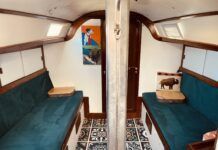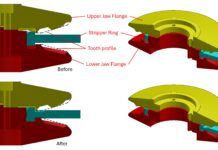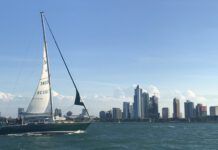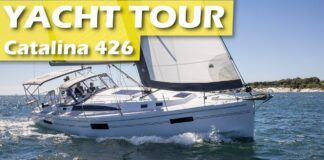Photo by Kay Goode and courtesy of Ken Jacks
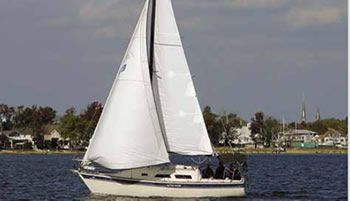
I have sailed a Tartan Fantail powered with a Torqeedo Cruise 2.0 a few times. I fell in love with the silence and the power of the engine, and as a result, I have my diesel for sale. I plan to replace it with an inboard, electric 48-volt powerplant. I have investigated quite a few.
The Torqeedo is as quiet as sailing, and you don’t even know that the engine is engaged until the boat starts moving. Getting rid of all the liquids required to run a diesel, water filters, fuel filters, oil filters, impellers, and the hassle of winterization really appeals to me. However, there are so many different kinds of motors and drive systems, a PS survey of the field and maybe a recommendation would be terrific.
Ken Jacks
Alexis Marie, 1985 Aloha 8.2
Annapolis, Md.
A reader survey is in the works, but in the mean time, be sure to visit our online archive and check out these past articles: Electric and Hybrid Propulsion for Sailboats (PS, September 2008), which discusses the various drive system options and products, and Lithium-ion Batteries for Powering Sailboats (PS, May 2011), which talks about powering these systems.
Because your boat is pocket-cruiser size with a 5,200-pound displacement, your options include and electric outboard as well as an electric alternative to your diesel engine. Be sure to educate yourself on the practical pros and cons of the outboard-style electric engines like the Torqeedo before making your decision.
We first looked at Torqeedos offerings in the January 2010 issue, and that article highlights the pros and cons of electric power for sailboats. Our January 2011 report compared three electric outboards, including two Torqeedo models and an Electric Paddle. And in our most recent review of gas-engine alternatives, we compared-and recommended-the propane-powered Lehr with the Torqeedo T-1003S and Yamahas 9.9F gas OB.
For those who own inboard auxiliary sailboats in the 5,000- to 15,000-pounds displacement range and are looking to convert to electric propulsion, the range of alternatives is growing. However, if youre looking for something more than propulsion in and out of the slip, be sure to factor in the cost of producing/storing energy and the installation, which can be considerable.
We are gearing up to test 6-horsepower outboards on our Catalina 22 test boat soon, and these will include the Torqeedo Travel 1003L and propane-powered Lehr LP5.0L. Stay tuned for those results.
It is interesting to see that scraping off old bottom paint is getting some press (see PS May 2014 Mailport online). It was more than 25 years ago that I scraped every single spec of bottom paint off a Pearson 323. It did not take long to realize that the corners of the scraper had to be rounded to prevent damaging the bottom and that keeping the blade sharp was key to success. It took several days of hard work and was a very unpleasant task, but scraping took far less effort and time than trying to accomplish the same result by sanding.
I recently took a different approach to stripping the bottom paint from my current boat, a Freedom 36. Recalling the grueling job of scraping a 32-foot boat, it was an easy decision to hire a company that specializes in stripping paint from boat bottoms and other surfaces, using a fine compound and compressed air to strip the paint quickly and economically with no damage to the boat, when done by an experienced professional. Additionally, this process left a consistent finish that was much the same as what I would have wanted to sand into the gelcoat prior to reapplying a fresh barrier primer coat, followed by the antifouling coating.
There was no degradation of the gelcoat above the waterline and no damage to through-hull fittings. I am not one to back away from sweat-equity projects, but given the speed and excellent outcome of the blasting process, I would never again consider scraping bottom paint.
Bruce Wasilewski
Cinereous, Freedom 36
Charlevoix, Mich.
Photo by Kay Goode and courtesy of Ken Jacks

In regard to your March 2014 review of the new Island Packet Blue Jacket 40: This is clearly a well thought-out design, albeit with conservative beam and waterline length. I have been aboard the boat and examined it fairly closely. One thing that stands out for a cruising boat, and not mentioned in your review, is the fact that the saloon benches are short and curved, so there is no way for even a moderately tall person to lie or sit lengthwise on them. As a tall person, this is a significant limitation.
I sail in the Pacific Northwest, where the weather is frequently less than ideal, so one has to spend time below, even in summer. To be able to sit or lie lengthwise is an important design element for the saloon berths. Additionally, to be able to use them as sleeping berths when cruising with a crowd is equally important. That will not be possible with these benches unless ones guests are short. Im waiting for the next Blue Jacket to come off the drafting board of this talented pair: the Blue Jacket 43.
Christopher Sherlock
Via www.practical-sailor.com
Im looking for information on waterproofing foul-weather gear. The only place I can find a product is West Marine. Did you do a review on the different waterproofing products for foul-weather gear or would you be doing a review in the future?
Phil Durbin
Kaycee D., Coronado 25
Via email
In the February 2012 issues Chandlery section, we evaluated foul-weather gear aftercare products marketed by sailing apparel-maker Gill (www.gillna.com). The kit included a re-proofing spray that testers liked better than Atsko Silicon Water Guard ($5/10.5 ounces), an inexpensive water-repellent spray that had a major chemical smell and proved less effective than the Gill re-proofer. The downside of the Gill spray is its price: $23 for 10 ounces, which is only enough to treat three jackets. The bonus is that its designed specifically for use on foulies.
In our more extensive tests of fabric waterproofing sprays (see PS February 2014 and June 2004 online), testers tapped Gold Eagles 303 High-Tech Fabric Guard spray as their favorite. These tests focused mainly on waterproofing canvas/Sunbrella, but the 303 is also safe to use on most foul-weather gear fabrics. However, we do recommend checking with the maker of your foulies before treating the fabric with the 303 ($26/16 ounces, www.303products.com).
Photo by Kay Goode and courtesy of Ken Jacks

In regard to your May 2014 article on cruising guides: I am the publisher of Atlantic Cruising Clubs Guides to Marinas. I was surprised that ACCs Guide to Mid-Atlantic/ICW Marinas was not among the guides reviewed in the article. If I missed a submission request directed to us, I apologize. If there was some other reason that our guide was not included, Id appreciate hearing that valuable feedback.
As an update, ACCs Guides to Marinas now cover every marina that accepts overnight transient boats (over 1,600 marinas) from Halifax, Nova Scotia, to Pensacola, Fla., on the East Coast and from Desolation Sound, B.C., to the OR-CA border, including all of Puget Sound. We publish for the cruising boater. Like Practical Sailor, ACC is completely independent and boater-biased-ACC does not accept advertising from or charge fees to any marinas selected for inclusion in the guides.
ACC publishes in print (7 geographical volumes), web (www.AtlanticCruisingClub.com), and PC formats. ACCs Guides rate marinas with regard to their dock, mooring, and other boat and boater-related facilities, haul-out and repair capabilities, and ability to handle vessels over 70 feet.
Our master marina database has 300 information fields for every marina as well as 25 photo image fields, and we believe ACCs full-page Marina Reports offer the most complete set of marina and whats nearby info available. Our writer/reviewers personally visit every marina included in ACCs guides.Their editorial comments provide insight not only to whats there but also whats going on in the area.
What are ACCs weaknesses? ACC is a small company, and we have historically updated our marina data every few years on a rolling geographical basis. ACCs Guide to Mid-Atlantic/ICW Marinas was published in 2010 but is scheduled for an update soon, ACCs Guide to New England and Canadian Marinas was updated in 2011, and ACCs Guide to Floridas West Coast Marinas was published in 2012.
In conclusion, I agree that most cruising boaters do as your article suggested-consult several guides depending on their interests and float plan. I believe that ACCs Guide to Mid-Atlantic/ICW Marinas is one of the most thorough and detailed marina guides for the ICW available and that your readers may well wish to add it to their cruising library.
Richard Smith, Publisher
Jerawyn Publishing /
Atlantic Cruising Club
We look forward to the new, updated mid-Atlantc/ICW guide book, and will gladly review it once its published.
Sailing gloves are often mesh and/or open on the back of the hand, which is exactly where harmful UV rays hit. I have searched for UV-blocking gloves without much success. Helming gloves need not have abrasion protection once the trim is set and could be from a non-marine supplier. What do burn victim or carcinoma survivors wear?
Chris Winsor
Via www.practical-sailor.com
Weve not yet tested gloves for sun protection but any fabric covering your hand will create a physical barrier and will offer some protection. Reader Robert Settle recommends fingerless gloves made by Dr. Shade. He said the Lycra-like material is rated UPF 50, and his have stood up to over two years of use. He added that they would not stand up to handling lines though.
We also suggest checking out gloves from companies specializing in sun-blocking apparel, like Coolibar, which sells the fingerless and full-finger aqua gloves. These look pretty heavy-duty and are saltwater-resistant. Coolibars regular gloves may be a better option for warm-weather sailing.

















